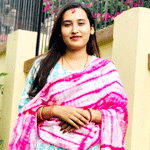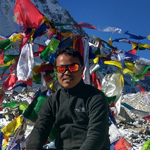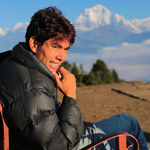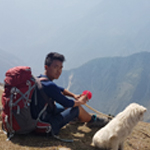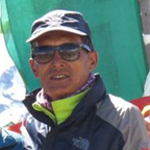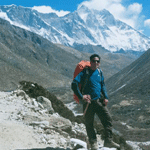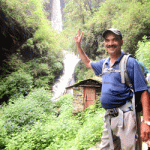LUMBINI BIRTHPLACE OF BUDDHA- One of the world's most important spiritual sites is home to the historic birthplace of the Buddha. Today you can visit over 25 international Buddhist monasteries, study Buddhism, meditation and visit Buddha's birthplace itself within the sacred Mayadevi Gardens.
Mayadevi Temple is one of the important sites in the Lumbini Garden with many historians and archaeologists referring to it as the place of birth of Lord Buddha. Inscriptions on the Ashoka Pillar also refers the spot as his birthplace. It is said that here the newly born Prince took his first seven steps and gave a peace message to humanity. This happened in the beautiful Sal grove, which is now the focal point of the Lumbini Garden. Mayadevi, the Queen of Shakya King Suddhodhana of Kapilvastu, while passing through the Lumbini Garden, on the day of Baishakha Purnima (full moon day of May in 623 BC) took a bath in the Pushkarini (the Sacred Pond) and soon after she took support of a tree branch, and gave birth to the Prince Siddhartha, who became the Buddha.
Visit beautiful monasteries built by different Buddhist countries like China, Japan, Sri Lanka, Myanmar, Germany and observe the different architecture and prayer areas. Soak up the peaceful atmosphere and above all visit the Mayadevi Temple which dates back to 2,200 years, which archaeological evidence proclaim as the birthplace of Siddhartha Gautam or Lord Buddha in 623 BC. You can walk around the garden or find a peaceful meditative spot to contemplate. The focal point for pilgrims is a sandstone carving depicting the birth of the Buddha, reputedly left here by the Malla King Ripu Malla, in the 14th century, when Mayadevi was worshipped as an incarnation of the Hindu mother goddess. Another main attraction is the Ashokan Pillar, which was built by the great Indian Emperor Ashoka while visiting the birthplace of Buddha back in 249 BC.
One can visit the Panditarama Vipassana Center for some yoga and meditation and interact with the monks, who live in the vicinity of the monasteries, devoting their time to balancing the environment with religious worship. The Lumbini Garden covers an area of 2.56 sq km or 1 x 3 sq miles and encompasses three zones each covering one square mile connected with walkways and a canal. The area has sub tropical monsoon climate with warm wet season. If you are planning on traveling to exotic places in South Asia looking to find some Nirvana, then do not miss Lumbini in Nepal.
Asoka Pillar the Holy Garden
It was here in the greenery enclosures of Lumbini that Prince Siddhartha Gautam, who later turned into the Buddha, was born in 623 BC. The nativity site is stamped by a commemorative pillar erected by Mauryan Emperor Asoka of India amid his journey to the holy site in 249 B.C. The inscription on the Asoka Pillar distinguishes the Sacred Garden – spread more than 9 sq. km – as the spot where the Enlightened One was born.
Maya Devi Temple
A substantial number of Buddhist travelers from everywhere throughout the world visit the birthplace of Buddha Lumbini to implore at the Maya Devi Temple where archaeological site has revealed the “marker stone” demonstrating the accurate spot where Siddhartha Gautam Buddha was born.
Puskarani Pond
The sacred Puskarani Pond where Queen Maya Devi had scrubbed down before the birth of Buddha lies the south of the pillar. It was likewise in this lake that the newborn child Buddha was given his first shower.
The Myanmar Golden Stupa
Which is also called Lokamani Cula Pagoda, it is a gleaming gold and white structure that looks like the Shwe-dagon Pagoda of Yangon while the International Gautama Nuns Temple is a copy of the Swoyambhunath Stupa of Kathmandu.
The China Monastery
The China Temple, assembled by the Buddhist Association of China, is a complex of pagodas, supplication to God rooms and contemplation cells. Over the street is the Dae Sung Suk GA SA Korean Temple.
The Japanese Peace Stupa
The stupa constructed by Nippon Jon Kyohoji of Japan, is a 41-m tall structure with four distinctive Buddha statues set into the stupa’s dome confronting the four cardinal directions.
The Great Lotus Stupa, German
The model of the Wonderful Lotus Stupa relies upon Buddha’s teachings and goes right back the content pieces of the impressive Tibetan scholar Rigzin Choskyi Drakpa. The popularity of ‘The Great Lotus Stupa’ is not just based on its stupa structure. More focus continues to be on constructing the stupa according to the religious norms. The dimensions and also design of stupas have already been based on concepts dating back thousands of years, right up to the times of Buddha.
Royal Thai Monastery, Thailand
Built in gleaming white marble, the Royal Thai Monastery in Lumbini is designed in Thai architecture. The beautiful design and carvings of this Monastery make this place one of the must visit sites in Lumbini. This is a part of Photo Journey to the birth place of Lord Buddha.
Kapilvastu Tilaurakot
An important archeological site near Lumbini premise, Kapilvastu, the ancient place where Lord Buddha spent his formative years. Scattered around are foundations of the ancient palace and archeologists have by now discovered 13 successive Layers of human habitation dating back to the eight century BC. A must visit site for archeological and historical enthusiasts. When the Buddha was born, Kapilvastu Tilaurakot was the capital of his father Suddhodhan’s Kingdom. It is 27 Kilometers west of Lumbini. The stupas, monasteries, and the places the Chinese traveler Hwen Sang mentioned in his travelogue more than two millennia ago no longer exist Nepal have preserved the location of the ancient town as a heritage site.
Lumbini Museum
The museum exhibits artifacts from Mauryan and also Kushana periods of time. The museum offers faith based scripts, metallic sculptures together with stamps from around the world depicting Lumbini.

